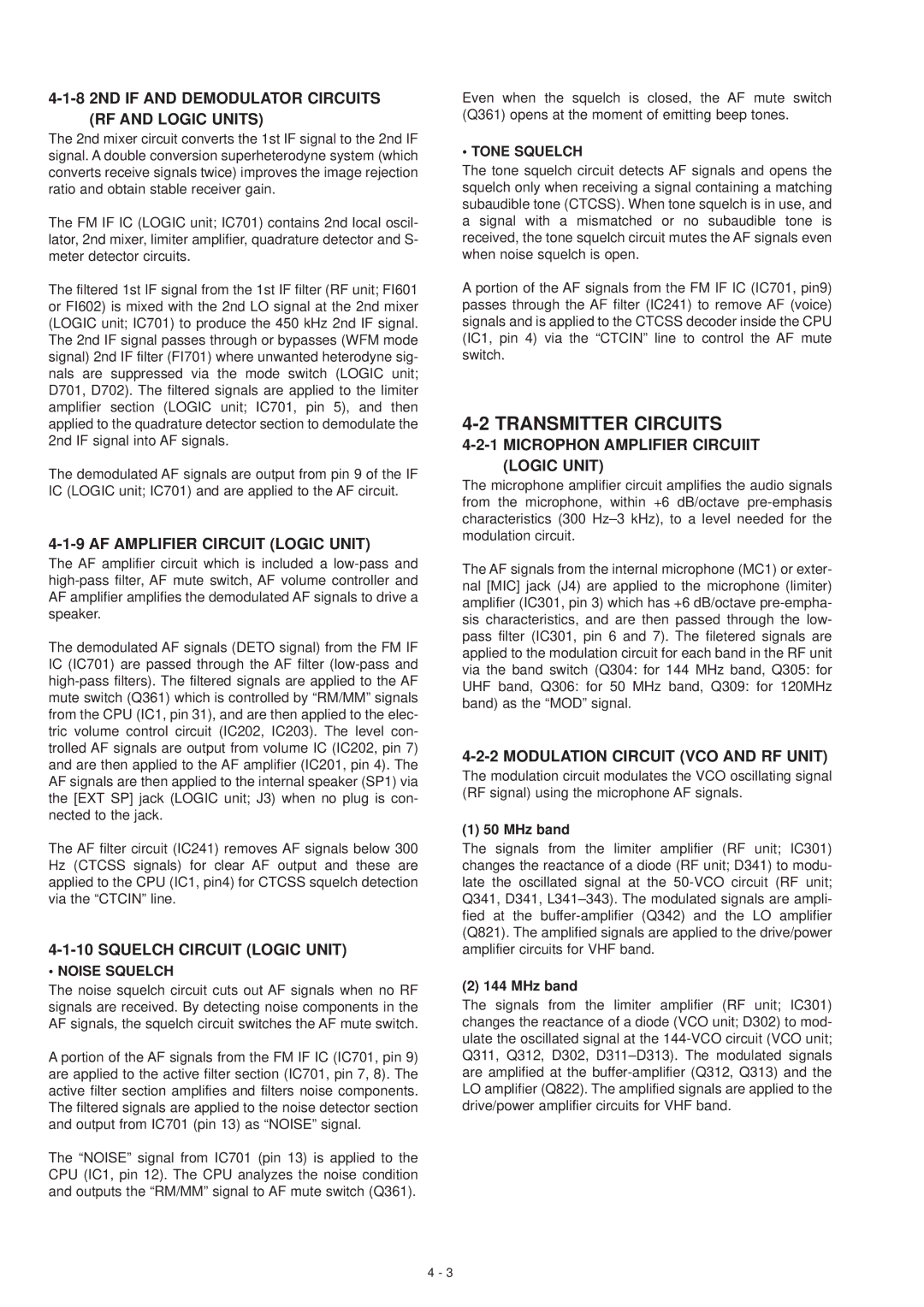4-1-8 2ND IF AND DEMODULATOR CIRCUITS (RF AND LOGIC UNITS)
The 2nd mixer circuit converts the 1st IF signal to the 2nd IF signal. A double conversion superheterodyne system (which converts receive signals twice) improves the image rejection ratio and obtain stable receiver gain.
The FM IF IC (LOGIC unit; IC701) contains 2nd local oscil- lator, 2nd mixer, limiter amplifier, quadrature detector and S- meter detector circuits.
The filtered 1st IF signal from the 1st IF filter (RF unit; FI601 or FI602) is mixed with the 2nd LO signal at the 2nd mixer (LOGIC unit; IC701) to produce the 450 kHz 2nd IF signal. The 2nd IF signal passes through or bypasses (WFM mode signal) 2nd IF filter (FI701) where unwanted heterodyne sig- nals are suppressed via the mode switch (LOGIC unit; D701, D702). The filtered signals are applied to the limiter amplifier section (LOGIC unit; IC701, pin 5), and then applied to the quadrature detector section to demodulate the 2nd IF signal into AF signals.
The demodulated AF signals are output from pin 9 of the IF IC (LOGIC unit; IC701) and are applied to the AF circuit.
4-1-9 AF AMPLIFIER CIRCUIT (LOGIC UNIT)
The AF amplifier circuit which is included a
The demodulated AF signals (DETO signal) from the FM IF IC (IC701) are passed through the AF filter
The AF filter circuit (IC241) removes AF signals below 300 Hz (CTCSS signals) for clear AF output and these are applied to the CPU (IC1, pin4) for CTCSS squelch detection via the “CTCIN” line.
4-1-10 SQUELCH CIRCUIT (LOGIC UNIT)
• NOISE SQUELCH
The noise squelch circuit cuts out AF signals when no RF signals are received. By detecting noise components in the AF signals, the squelch circuit switches the AF mute switch.
A portion of the AF signals from the FM IF IC (IC701, pin 9) are applied to the active filter section (IC701, pin 7, 8). The active filter section amplifies and filters noise components. The filtered signals are applied to the noise detector section and output from IC701 (pin 13) as “NOISE” signal.
The “NOISE” signal from IC701 (pin 13) is applied to the CPU (IC1, pin 12). The CPU analyzes the noise condition and outputs the “RM/MM” signal to AF mute switch (Q361).
Even when the squelch is closed, the AF mute switch (Q361) opens at the moment of emitting beep tones.
• TONE SQUELCH
The tone squelch circuit detects AF signals and opens the squelch only when receiving a signal containing a matching subaudible tone (CTCSS). When tone squelch is in use, and a signal with a mismatched or no subaudible tone is received, the tone squelch circuit mutes the AF signals even when noise squelch is open.
A portion of the AF signals from the FM IF IC (IC701, pin9) passes through the AF filter (IC241) to remove AF (voice) signals and is applied to the CTCSS decoder inside the CPU (IC1, pin 4) via the “CTCIN” line to control the AF mute switch.
4-2 TRANSMITTER CIRCUITS
4-2-1 MICROPHON AMPLIFIER CIRCUIIT (LOGIC UNIT)
The microphone amplifier circuit amplifies the audio signals from the microphone, within +6 dB/octave
The AF signals from the internal microphone (MC1) or exter- nal [MIC] jack (J4) are applied to the microphone (limiter) amplifier (IC301, pin 3) which has +6 dB/octave
4-2-2 MODULATION CIRCUIT (VCO AND RF UNIT)
The modulation circuit modulates the VCO oscillating signal (RF signal) using the microphone AF signals.
(1) 50 MHz band
The signals from the limiter amplifier (RF unit; IC301) changes the reactance of a diode (RF unit; D341) to modu- late the oscillated signal at the
(2) 144 MHz band
The signals from the limiter amplifier (RF unit; IC301) changes the reactance of a diode (VCO unit; D302) to mod- ulate the oscillated signal at the
4 - 3
